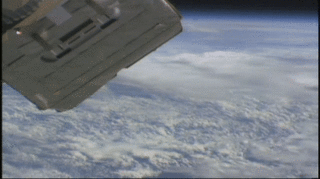ISS - Expedition 50 Mission patch.
Feb. 24, 2017
International Space Station (ISS). Animation Credit: NASA
(Highlights: Week of Feb. 13, 2017) - It was harvest week for another crop of vegetables on the International Space Station.
NASA astronaut Peggy Whitson photographed and harvested Tokyo Bekana cabbage – also known as Chinese cabbage – capping another round of the Veg-03 investigation. Understanding how plants respond to microgravity is an important step for future long-duration space missions, which will require crew members to grow their own food. Astronauts on the station have previously grown lettuce and flowers in the Veggie facility. This new series of the study expanded on previous validation tests. Whitson froze some of the crop for return to Earth, and set aside some for mealtime with the crew before cleaning and drying the facility.
Veggie provides lighting and necessary nutrients for plants by using a low-cost growth chamber and planting pillows, which deliver nutrients to the root system. The Veggie pillow concept is a low-maintenance, modular system that requires no additional energy beyond a special light to help the plants grow. It supports a variety of plant species that can be cultivated for fresh food, and even for education experiments.
Image above: NASA astronaut Shane Kimbrough works on the Capillary Flow Experiment on the space station. This study examines how liquid flows in space and could improve the reliability of water purification, fuels storage and supply, and general liquid transport on spacecraft. Image Credit: NASA.
Crew members have commented that they enjoy space gardening, and investigators believe growing plants could provide a psychological benefit to crew members on long-duration missions, just as gardening is often an enjoyable hobby for people on Earth. Data from this investigation could benefit agricultural practices on Earth by designing systems that use valuable resources such as water more efficiently.
ESA (European Space Agency) astronaut Thomas Pesquet completed over 15 test runs for the final operations of the Capillary Flow Experiment (CFE-2), working with the ground team to collect important data for new mathematical models of liquid flow types. Liquids behave differently in space than they do on Earth, so containers that can process, hold or transport them must be designed carefully to work in microgravity. The Capillary Flow Experiment furthers research on wetting, which is a liquid’s ability to spread across a surface. The study demonstrates how capillary forces work in space, how differently shaped containers change the wicking behavior of a wetting fluid, and how such can be used to passively separate liquids and gases. Understanding how microgravity amplifies these behaviors could improve the reliability of such key processes as water purification, fuel storage and supply, and general liquid transport aboard spacecraft.
Image above: NASA astronaut Peggy Whitson harvested Tokyo Bekana cabbage – also known as Chinese cabbage – capping another round of the Veg-03 investigation. Image Credit: NASA.
On Earth, capillary action allows small amounts of liquid to flow up and into tight spaces despite the effects of gravity. New miniature medical devices, known as lab-on-a-chip technologies, exploit this phenomenon to draw blood or other fluids into essentially miniature diagnostic systems. CFE-2 improves our understanding of how capillary forces work in a variety of system geometries including the open spaces within porous materials such as sand and soil, wicks and sponges.
NASA astronaut Shane Kimbrough moved the Simple Solar Neutron Detector from the U.S. Lab to Node 1, continuing the study of solar radiation on the space station. Like any star, our sun gives off neutron radiation. The physical properties of neutrons, in particular the absence of electric charge, presents significant challenges to their detection. Astronauts are particularly sensitive to low-energy neutron exposure, which has adverse health consequences, and can cause materials fatigue and degradation issues if spacecraft components are exposed to solar neutrons over long periods.
Image above: ESA astronaut Thomas Pesquet and NASA astronaut Peggy Whitson setup the Microgravity Science Glovebox (MSG) in preparation for the Expanded Stem Cells investigation. Image Credit: NASA.
This investigation from the University of Nebraska in Lincoln involves a new type of detector on the station to measure solar neutrons of lower energy. In addition to confirming decades-long predictions that the sun generates neutrons, the project investigates radiation damage and materials fatigue associated with these neutrons. A space-based approach is essential to this task, since ground-based neutron detectors are subject to interference as interactions of energetic particles with the atmosphere create secondary, non-solar neutrons.
Human research investigations conducted this week include Biochemical Profile, Repository, Fine Motor Skills, Habitability, Space Headaches, Multi-Omics, and Dose Tracker.
Progress was made on other investigations, outreach activities, and facilities this week, including Microgravity Expanded Stem Cells, Rodent Research-4, EPO Pesquet, Google Street View, ISS Ham Radio, Group Combustion, JAXA Electrostatic Levitation Furnace, Plasma Kristall-4, Robotic External Leak Locator, NanoRacks CubeSat Deployer, RFID Logistics Awareness, Robonaut, SPHERES-UDP, and Manufacturing Device.
Related links:
Veg-03: http://www.nasa.gov/mission_pages/station/research/experiments/1294.html
Veggie facility: http://www.nasa.gov/mission_pages/station/research/experiments/383.html
Capillary Flow Experiment (CFE-2): https://www.nasa.gov/mission_pages/station/research/experiments/459.html
Simple Solar Neutron Detector: https://www.nasa.gov/mission_pages/station/research/experiments/2296.html
Biochemical Profile: https://www.nasa.gov/mission_pages/station/research/experiments/1008.html
Repository: https://www.nasa.gov/mission_pages/station/research/experiments/981.html
Fine Motor Skills: https://www.nasa.gov/mission_pages/station/research/experiments/1767.html
Habitability: https://www.nasa.gov/mission_pages/station/research/experiments/1772.html
Space Headaches: https://www.nasa.gov/mission_pages/station/research/experiments/181.html
Multi-Omics: https://www.nasa.gov/mission_pages/station/research/experiments/1949.html
Dose Tracker: http://www.nasa.gov/mission_pages/station/research/experiments/1933.html
Microgravity Expanded Stem Cells: https://www.nasa.gov/mission_pages/station/research/experiments/1971.html
Rodent Research-4: https://www.nasa.gov/mission_pages/station/research/experiments/2025.html
ISS Ham Radio: http://www.nasa.gov/mission_pages/station/research/experiments/346.html
Group Combustion: https://www.nasa.gov/mission_pages/station/research/experiments/1077.html
JAXA Electrostatic Levitation Furnace: https://www.nasa.gov/mission_pages/station/research/experiments/1999.html
Plasma Kristall-4: https://www.nasa.gov/mission_pages/station/research/experiments/1343.html
Robotic External Leak Locator: https://www.nasa.gov/mission_pages/station/research/experiments/1817.html
NanoRacks CubeSat Deployer: http://nanoracks.com/products/smallsat-deployment/
RFID Logistics Awareness: https://www.nasa.gov/mission_pages/station/research/experiments/2137.html
Robonaut: https://www.nasa.gov/mission_pages/station/research/experiments/760.html
SPHERES-UDP: https://www.nasa.gov/mission_pages/station/research/experiments/1814.html
Manufacturing Device: https://www.nasa.gov/mission_pages/station/research/experiments/2198.html
Space Station Research and Technology: https://www.nasa.gov/mission_pages/station/research/index.html
International Space Station (ISS): https://www.nasa.gov/mission_pages/station/main/index.html
Animation (mentioned), Images (mentioned), Text, Credits: NASA/Kristine Rainey/Vic Cooley, Lead Increment Scientist Expeditions 49 & 50.
Best regards, Orbiter.ch

















































